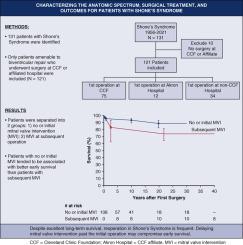The Journal of Thoracic and Cardiovascular Surgery ( IF 6 ) Pub Date : 2022-06-02 , DOI: 10.1016/j.jtcvs.2022.05.030 Leah J Lee 1 , Dominique L Tucker 1 , Sohini Gupta 1 , Naseeb Shaheen 2 , Jeevanantham Rajeswaran 3 , Tara Karamlou 4 ,

|
Objective
Shone's syndrome (SS) has a varied anatomic spectrum without consensus on need and timing for mitral valve intervention (MVI). We sought to (1) characterize the anatomic spectrum and treatment pathways; (2) describe long-term outcomes and their determinants; and (3) define the impact of MVI timing on survival.
Methods
In total, 121 patients with SS who underwent operation at Cleveland Clinic between 1956 and 2021 were reviewed. Multivariable parametric hazard analyses including time-varying covariables, and modulated renewal to account for repeated events, were performed. End points included time-related survival and reintervention.
Results
Median follow-up was 9.9 years. Mitral stenosis (MS) (98%), coarctation (80%), and aortic stenosis (70%) predominated. The most common combination was MS + aortic stenosis + coarctation (26%). Median initial mean mitral and aortic gradients were 3.6 (15th/85th percentiles: 2.0/6.8) and 9.0 (2.1/46) mm Hg, respectively. Median initial surgery age was 0.041 (0.011/3.2) years. Initial surgeries included coarctation repair (43%), arch repair (18%), and staged biventricular repair (18%). Overall survival was 92% at 20 years. Freedom from reoperation was 66% and 24% at 1 and 20 years. Patients with no MVI or initial MVI (N = 7) tended to be associated with better early survival compared with those with MVI at subsequent operation (N = 29) (P = .06). Risk factors for early reintervention included initial Norwood operation, with younger age and arch hypoplasia increasing later reintervention.
Conclusions
Despite excellent long-term survival, reoperation in SS is frequent and occurs most commonly on left ventricular outflow tract and mitral valve. Although MS is present in most, few require MVI. Delaying MVI may compromise early survival.
中文翻译:

描述肖恩综合征患者的解剖谱、手术治疗和长期临床结果
客观的
肖恩综合征 (SS) 具有多种解剖学特征,但对于二尖瓣介入治疗 (MVI) 的需求和时机尚未达成共识。我们试图(1)描述解剖谱和治疗途径的特征;(2) 描述长期结果及其决定因素;(3) 定义 MVI 时机对生存的影响。
方法
总共对 1956 年至 2021 年间在克利夫兰诊所接受手术的 121 名 SS 患者进行了回顾。进行了多变量参数危险分析,包括时变协变量和考虑重复事件的调制更新。终点包括与时间相关的生存率和再干预。
结果
中位随访时间为 9.9 年。二尖瓣狭窄 (MS) (98%)、缩窄 (80%) 和主动脉瓣狭窄(70%) 占主导地位。最常见的组合是 MS + 主动脉瓣狭窄 + 缩窄 (26%)。中位初始平均二尖瓣和主动脉梯度分别为 3.6(第 15/85 个百分位数:2.0/6.8)和 9.0(2.1/46)mm Hg。中位初次手术年龄为 0.041 (0.011/3.2) 岁。最初的手术包括缩窄修复(43%)、弓修复(18%)和分期双心室修复(18%)。20 年总生存率为 92%。1 年和 20 年免再手术率分别为 66% 和 24%。与随后手术时有 MVI 的患者 (N = 29) 相比,无 MVI 或初始 MVI 的患者 (N = 7) 往往具有更好的早期生存率 ( P = .06)。早期再干预的危险因素包括最初的诺伍德手术,年龄较小和牙弓发育不全会增加后来的再干预。
结论
尽管长期生存率极好,但 SS 的再次手术很频繁,并且最常见于左心室流出道和二尖瓣。尽管大多数患者存在 MS,但很少需要 MVI。延迟 MVI 可能会影响早期生存。


























 京公网安备 11010802027423号
京公网安备 11010802027423号